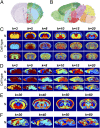Cell type-specific genes show striking and distinct patterns of spatial expression in the mouse brain
- PMID: 23386717
- PMCID: PMC3581870
- DOI: 10.1073/pnas.1222897110
Cell type-specific genes show striking and distinct patterns of spatial expression in the mouse brain
Abstract
To characterize gene expression patterns in the regional subdivisions of the mammalian brain, we integrated spatial gene expression patterns from the Allen Brain Atlas for the adult mouse with panels of cell type-specific genes for neurons, astrocytes, and oligodendrocytes from previously published transcriptome profiling experiments. We found that the combined spatial expression patterns of 170 neuron-specific transcripts revealed strikingly clear and symmetrical signatures for most of the brain's major subdivisions. Moreover, the brain expression spatial signatures correspond to anatomical structures and may even reflect developmental ontogeny. Spatial expression profiles of astrocyte- and oligodendrocyte-specific genes also revealed regional differences; these defined fewer regions and were less distinct but still symmetrical in the coronal plane. Follow-up analysis suggested that region-based clustering of neuron-specific genes was related to (i) a combination of individual genes with restricted expression patterns, (ii) region-specific differences in the relative expression of functional groups of genes, and (iii) regional differences in neuronal density. Products from some of these neuron-specific genes are present in peripheral blood, raising the possibility that they could reflect the activities of disease- or injury-perturbed networks and collectively function as biomarkers for clinical disease diagnostics.
Conflict of interest statement
The authors declare no conflict of interest.
Figures



References
-
- Kandel ER. Principles of Neural Science. 4th Ed. New York: McGraw-Hill; 2000.
-
- Sugino K, et al. Molecular taxonomy of major neuronal classes in the adult mouse forebrain. Nat Neurosci. 2006;9(1):99–107. - PubMed
-
- Lein ES, et al. Genome-wide atlas of gene expression in the adult mouse brain. Nature. 2007;445(7124):168–176. - PubMed
Publication types
MeSH terms
Substances
LinkOut - more resources
Full Text Sources
Other Literature Sources
Molecular Biology Databases

